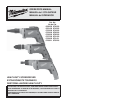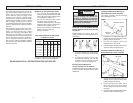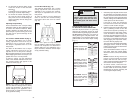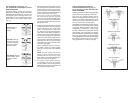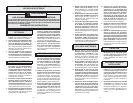
6 7
WARNING
TOOL ASSEMBLY
To reduce the risk of injury,
always unplug tool before at-
taching or removing accessories
or making adjustments. Use only spe-
cifi cally recommended accessories.
Others may be hazardous.
Removing and Replacing Quik-Lok
®
Cords (Fig. 1) Cat. No. 6580-20, 6581-20,
6702-20, 6703-20, 6706-20, 6707-20, 6708-
20, 6791-20
MILWAUKEE's exclusive Quik-Lok
®
Cords provide instant fi eld replacement or
substitution.
Fig. 1
1. To remove the Quik-Lok
®
Cord, turn the
cord nut 1/4 turn to the left and pull it
out.
2. To replace the Quik-Lok
®
Cord, align
the connector keyways and push the
connector in as far as it will go. Turn the
cord nut 1/4 turn to the right to lock.
Installing Driving Mechanism
Cat. No. 6706-20, 6707-20, 6708-20
Install the fi nal driving mechanism according
to the instructions included with the tool's
attachment.
Installing and Removing Bits (Fig. 2)
TEKS Ramp-Off Locator Assembly
The locator assembly must be removed
when changing bit sizes.
1. Unplug tool. To remove the locator as-
sembly, turn the ramp-off sleeve while
pulling it away from the tool.
2. Pull out the magnetic socket and
replace it with a new socket.
3. Push the locator assembly onto the nose
of the tool until it snaps into place.
Installing and Removing Bits (Fig. 3)
Drywall Ramp-Off Locator Assembly
Fig. 2
Magnetic socket
Locator
Ramp-off
sleeve
Fig. 3
Bit holder
Insert bit
Locator
Ramp-off
sleeve
1. Unplug tool. To remove the locator as-
sembly, turn the ramp-off sleeve while
pulling it away from the tool.
2. Push insert bit into bit holder until it
snaps into place. Push the bit holder
into the nose of the tool until it snaps
into place.
3. Push the locator assembly onto the nose
of the tool until it snaps into place.
Grounded tools require a three wire exten-
sion cord. Double insulated tools can use
either a two or three wire extension cord.
As the distance from the supply outlet
increases, you must use a heavier gauge
extension cord. Using extension cords with
inadequately sized wire causes a serious
drop in voltage, resulting in loss of power
and possible tool damage. Refer to the table
shown to determine the required minimum
wire size.
The smaller the gauge number of the wire,
the greater the capacity of the cord. For ex-
ample, a 14 gauge cord can carry a higher
current than a 16 gauge cord. When using
more than one extension cord to make up
the total length, be sure each cord contains
at least the minimum wire size required. If
you are using one extension cord for more
than one tool, add the nameplate amperes
and use the sum to determine the required
minimum wire size.
Guidelines for Using Extension Cords
• If you are using an extension cord out-
doors, be sure it is marked with the suffi x
“W-A” (“W” in Canada) to indicate that it
is acceptable for outdoor use.
• Be sure your extension cord is prop-
erly wired and in good electrical
condition. Always replace a damaged
extension cord or have it repaired by a
qualifi ed person before using it.
• Protect your extension cords from sharp
objects, excessive heat and
damp or wet areas.
READ AND SAVE ALL INSTRUCTIONS FOR FUTURE USE.
Recommended Minimum Wire Gauge
for Extension Cords*
Extension Cord Length
* Based on limiting the line voltage drop to
fi ve volts at 150% of the rated amperes.
Nameplate
Amperes
0 - 2.0
2.1 - 3.4
3.5 - 5.0
5.1 - 7.0
7.1 - 12.0
12.1 - 16.0
16.1 - 20.0
25'
18
18
18
18
16
14
12
75'
18
18
16
14
12
10
100'
18
16
14
12
10
150'
16
14
12
12
50'
18
18
18
16
14
12
10
EXTENSION CORDS



